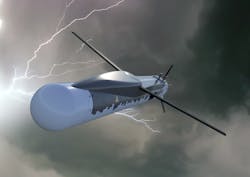Leidos eyes networked sensors and signal processing to detect, pinpoint, and attack high-value targets
WRIGHT-PATTERSON AFB, Ohio – U.S. military researchers are working with Leidos Inc. in Reston, Va., on a secretive networked sensors and signal-processing project to speed the detection and targeting of enemy high-priority targets.
Officials of the U.S. Air Force Research Laboratory at Wright-Patterson Air Force Base, Ohio, announced a $3 million contract to Leidos on Tuesday for the Military Tactical Means (MTM) project.
Details and specifications of the MTM project are classified, but it seeks to design advanced sensing and automated signal processing of remotely sensed data for detection, classification, and geolocation of adversary military equipment on the battlefield.
The MTM program aims to develop sensors and exploitation techniques capable of performing wide-area searches to detect high-value targets. Program design will provide the ability to identify high-value adversary targets and to maintain positive chain-of-custody hand-offs. In addition, MTM will have the potential to be used in highly proliferated systems, such as small platforms.
Related: U.S. Army chooses DRS to build the LLDR 3 target designation and laser range finder
The Air Force Research Laboratory awarded the contract on behalf of the U.S. Defense Advanced Research Projects Agency (DARPA) in Arlington, Va.
The project is part of the DARPA Mosaic Warfare vision, which seeks to create rapidly reconfigurable military forces that are fast, unpredictable, flexible, and adaptable -- more like the pieces in a mosaic piece of art, rather than a collection of rigidly designed pieces of a puzzle.
Mosaic warfare involves military forces that move quickly, adapt to changing circumstances, and continue to function efficiently even though some segments may disappear or be called away to higher-priority missions.
Related: EO/IR sensors boost situational awareness
The MTM project seeks to develop multi-mode electro-optics, sensors, and exploitation techniques for wide-area searches to detect high-value targets and destroy or disable these targets quickly using networked weapon systems.
The MTM project will consist of two 24-month phases. The first phase consists of two technical areas to be completed in parallel over two years. The second phase will have only one technical area.
The MTM project is one example of programs that are part of the DARPA Mosaic Warfare vision. Another example is the DARPA Timely Information for Maritime Engagements (TIMEly) project, which kicked-off last June. TIMEly mosaic warfare into the maritime realm, and involves assets like manned submarines and unmanned underwater vehicles (UUVs) to provide options on the fly for carrying out different missions.
TIMEly seeks to develop a heterogeneous maritime communications architecture, and the demonstrate a prototype during sample missions at sea. The project emphasizes undersea communications, as well as communications among manned and unmanned submarines, surface vessels, aircraft, and satellites.
TIMEly networks must be able to work together with established military networks to be effective, DARPA researchers say. The undersea domain imposes well-known limits on communications and on the ability to transfer the right information to warfighters.
For more information contact Leidos online at www.leidos.com, the Air Force Research Laboratory at www.wpafb.af.mil/afrl, or DARPA at www.darpa.mil/program/military-tactical-means.
About the Author
John Keller
Editor-in-Chief
John Keller is the Editor-in-Chief, Military & Aerospace Electronics Magazine--provides extensive coverage and analysis of enabling electronics and optoelectronic technologies in military, space and commercial aviation applications. John has been a member of the Military & Aerospace Electronics staff since 1989 and chief editor since 1995.
